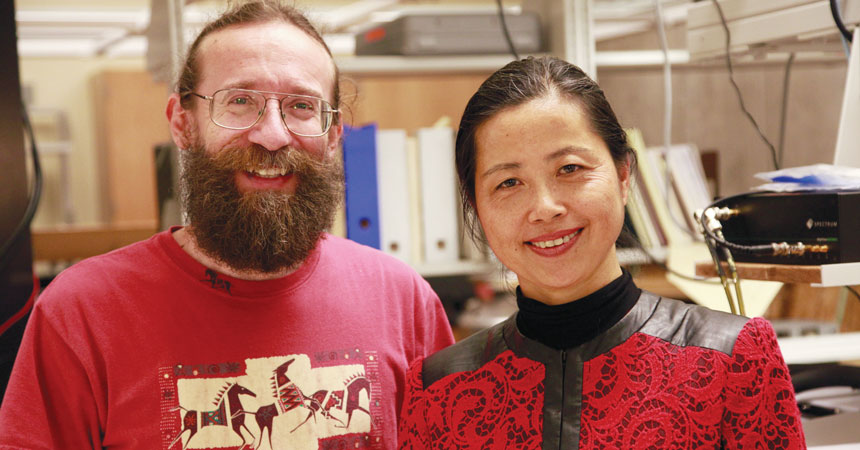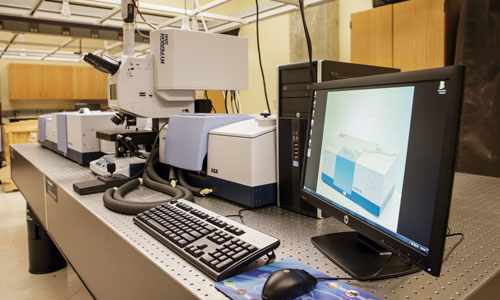Interdisciplinary, International and Intertwined
Wednesday, March 22, 2017

Wouter (“VOW-ter”) Hoff and Aihua (“A-wah”) Xie met at an international conference in Leiden, the Netherlands, in 1994. Two years later, he was receiving the Netherlands’ Society of Biophysics award for best Ph.D. thesis (given every two years) and she was at the ceremony, for she was conducting experiments using an International Infrared Free Electron facility in the country. Eventually they settled in at Oklahoma State, with offices next door to each other, though “settling” is not a word often associated with Hoff and Xie. In fact, both came to the United States because they were unable to quiet the rumblings of academic pursuits in their home countries.
Xie was fortunate enough to be part of the first wave of Chinese students admitted to a higher education institution following a decadelong nationwide suppression of formal education brought on by the Cultural Revolution. The odds of admission were microbial, yet there was Xie, only six months removed from secondary school, admitted with — and above — those up to 10 years older. She further proved to be among the best of the best when she earned inclusion into a new international exchange program, which allowed her to study physics in the United States.
Hoff also came to the United States in search of opportunity. In 2014, The Netherlands showed a population of just under 17 million people, somewhere between the populations of Illinois and New York. Though he was able to remain in his hometown of Amsterdam all the way through the completion of his thesis, he knew he would have to leave to continue his research. Speaking generally of his home country, Hoff says, “If you want to stay in science, you go abroad.”

And that is precisely what Hoff and Xie did. Hoff landed the prestigious Damon Runyon-Walter Winchel Foundation post-doctoral fellowship at the University of Houston while Xie took a faculty position at Albert Einstein College of Medicine in New York. In 1997, she came to OSU as an assistant professor of physics. Hoff spent two years as a post-doc at OSU before taking a full-time faculty position at the University of Chicago. He would not return to OSU until 2005.
“For a number of years, we commuted 600 miles between Stillwater and Chicago, then the opportunity arose where we could both work at OSU, and that was a great solution to our ‘two-body’ problem,” Hoff says.
The OSU Department of Microbiology and Molecular Genetics offered him an associate professorship in 2005 and a full professorship in 2011. He also serves as an adjunct faculty member in the Department of Chemistry and heads the graduate program in Microbiology/Molecular and Cell Biology. Xie was named a full professor in 2006.
Today, Hoff and Xie are separated by fewer than 600 millimeters, with offices side-by-side in the Henry Bellmon Research Center. The beautiful, state-of-the-art facility houses, among other things, Xie’s Fourier Transform Infrared Spectroscopy (FTIR) research laboratory, which has commanded approximately $1.6 million in outside research funding. She believes the NSF MRI funding for this Advanced FTIR Lab is greatly enhanced with the multidisciplinary environment created by the HBRC.
“This building really capitalizes on collaborations, particularly interdisciplinary collaborations,” Xie says. She was a member of the planning committee, architect committee and the user committees for the HBRC and dreams of its expansion, or even a second building, on campus.
Her enthusiasm for this emerging technology is palpable for she has just scratched the surface of its applications. Think of FTIR as an Xray, only at the chemical level. FTIR research could make life-changing discoveries in biomedical, bioenergy, and agricultural sciences. It has also been used to assess the authenticity of paintings by Leonardo DaVinci.
Hoff sits across a table from Xie and it quickly becomes apparent the two still share a freshman’s excitement for each other. Though both are internationally respected researchers, th ey become almost embarrassed when discussing their own achievements, so one must fill in the blanks for the other. Twenty-six seconds after Hoff begins to tell of his journey to the United States, Xie interrupts.
“Let me just add two things about Wouter,” she interjects. With deep fondness she mentions his thesis awards and adds another important fact he missed: Hoff discovered one of six known chromophores (molecules that detect color in nature) while at the University of Amsterdam.
“I forgot all that stuff,” Hoff laughs. “It’s good to have such a great fan.”
This discovery of P-coumaric acid has led to Hoff’s work being quoted more than 2,000 times in international research. Better still, it provided a springboard to the Cancer Research Foundation honoring him with its Young Investigator Award in 1999.
Research is a passion for both Hoff and Xie but it is not their only passion. They are also dedicated to teaching and serving an international audience.
Hoff is excited about a current program funded by the Howard Hughes Medical Institute. The program involves the creation of a Life Sciences Freshman Research Scholar cohort, which consisted of 32 OSU students in its first year, and Hoff’s involvement, which is directing students in his introductory microbiology course to conduct real, authentic research by isolating new strains of bacteria. The first wave of research resulted in three publications for three genomes isolated by first-year students.
The idea of combining research with instruction is carried on by Xie with her upper-level and graduate physics students. She believes it is the best way to cure what has been described as the STEM (science, technology, engineering, mathematics) “crisis” in the United States.
“I think we’re both trying to do two themes,” Hoff says of their teaching methods. “Tone is active learning, not just looking at a PowerPoint. The second theme is ‘authentic.’ It is not a fake exercise. It is really something useful, relevant, and interesting.”
Another key to success in the classroom is simply to listen to the student, Xie notes.
“If you just tell the student, ‘Do exactly this,’ that’s when we bore them to death,” Xie says. “When you learn for yourself, you are motivated.”
Along with research and teaching, Hoff feels the third pillar of their success is service. He became the graduate program coordinator for microbiology and revamped the first-year graduate curriculum in microbiology and created an accelerated master’s program. Additionally, Hoff serves as the editor of the highly respected Journal of Biological Chemistry.
A turning point for Xie came in 2005 when she helped organize a National Science Foundation-funded workshop for professional skill development for women physicists in 2005. The program has become a yearly event, and Xie still uses its skills today.
Xie continues to take down stereotypes about women in physics, culminating in her election as chair of the Biological Physics Commission of the International Union of Pure and Applied Physics in 2015. The commission, known as C6, promotes international cooperation in biological physics from both developing and developed countries. She is already organizing a meeting in Brazil for the summer of 2016. She will be joined by 10,000 physicists.
“So, what are you going to do next?” Hoff jokes.
The punch line may be on us. Armed with industrial-sized beakers full of ideas — and already having shown the ability to bring their ideas to life — Hoff and Xie actively search for the next thing and have little interest in repeating an experiment.
“What we are striving to do is to make a new step — boldly go where no one has gone before,” Hoff says.
As large as their imaginations may be, it is unlikely Hoff and Xie could have predicted they would settle in Stillwater. At OSU, they found the perfect place to build upon their three pillars of research, teaching and service.
Story by Brian Petrotta
